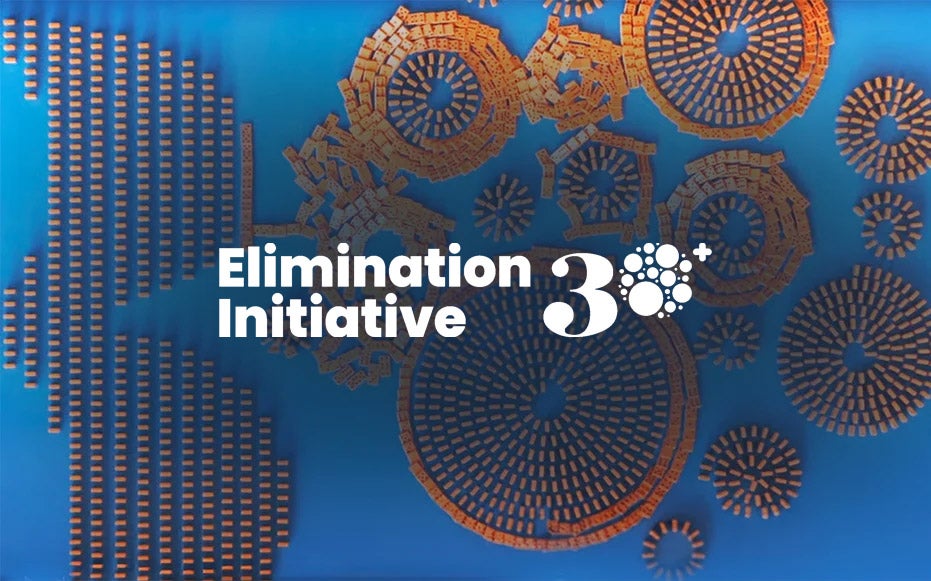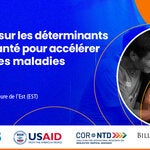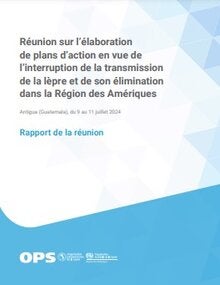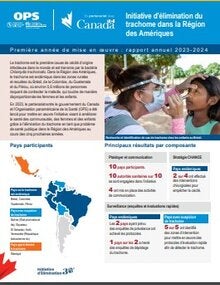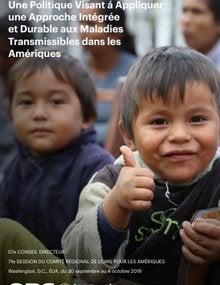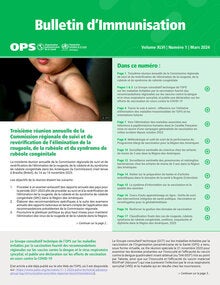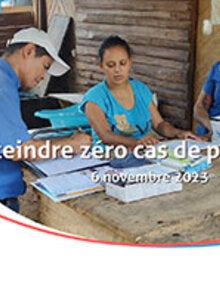À l'OPS, nous nous sommes engagés à mettre fin à plus de 30 maladies et conditions associées d'ici 2030. L'Initiative d'élimination des maladies est une politique innovante qui encourage une approche intégrée et durable dans le but d’accélérer les progrès vers les objectifs d'élimination dans la Région des Amériques.
Notre engagement dans le cadre de l'Initiative d'élimination est d'améliorer la qualité de vie des personnes et des communautés. Nous sommes par conséquent amenés à penser et à agir différemment, et à créer des synergies et des stratégies de transformation. Nous devons agir pour mettre fin aux souffrances et aux préjudices causés par les maladies transmissibles, afin que la santé progresse et que les communautés prospèrent.
Pourquoi maintenant ?
Nous sommes à un moment critique. Depuis des décennies, la Région des Amériques a franchi des étapes remarquables dans l'élimination des maladies. La variole a été éradiquée en 1980, suivie par l'élimination de la polio. La rubéole, le syndrome de rubéole congénitale et le tétanos néonatal ont également été éliminés. Début 2024, 19 pays étaient exempts de paludisme et 11 pays avaient mis fin à la transmission mère-enfant du VIH et de la syphilis. Toutefois, des défis subsistent. La pandémie de COVID-19 a entraîné des perturbations dans les interventions sanitaires et un recul concernant des progrès obtenus. Nous devons désormais saisir l'occasion pour accélérer l'élimination des maladies.



Pourquoi investir ? Parce que cela en vaut la peine !
Selon les estimations mondiales, l'investissement dans l'élimination des maladies stimule le bien-être et l'économie :
1. Maladies infectieuses négligées :
Pour chaque dollar investi dans l'élimination de ces maladies, le bénéfice net est d'environ US$ 25. Soit un taux de rendement annualisé de 30 % : une victoire financière pour la santé mondiale.
2. Impact socio-économique :
L'élimination de la lèpre, de la leishmaniose et de la maladie de Chagas ne concerne pas uniquement la santé, mais aussi l’économie. Le retour sur investissement s’élève à US$ 16,6 milliards sur la période 2021-2030, ajoutés à US$10,4 milliards de dépenses en moins.
3. Tuberculose :
Un investissement dans le diagnostic et le traitement de la maladie permet d'obtenir un retour sur investissement d’US$ 30 à US$ 115 par dollar investi. Le choix est judicieux.
4. Disparition de l'infection par le VIH :
La réalisation des objectifs en matière de VIH permet d'économiser US$ 24 milliards en coûts de traitement, soit un retour sur investissement 15 fois supérieur. Des vies transformées et des économies stimulées.
5. La magie de la vaccination :
Chaque dollar investi dans la vaccination génère un rendement d’US$ 26,35. Protéger des vies, améliorer la productivité : les avantages sont évidents.
Faits notables
Notre engagement continu a un profond impact sur l'ensemble de la Région des Amériques.
Exemples de réussite en matière d'élimination
Certifications et validations récentes
Les résultats de cette initiative représentent des jalons qui correspondent à une amélioration considérable de la qualité de vie des personnes et des communautés. L'engagement des pays, des communautés, des partenaires, des donateurs, des alliés et de l'OPS se reflète dans ces réalisations.
Transmission mère-enfant du VIH et de la syphilis
Pays certifiés exempts de transmission mère-enfant du VIH et de la syphilis
Objectifs d'élimination pour 2030
Maladies transmissibles et conditions associées dont l'élimination est proposée pour 2030
Objectif d'élimination
< 4 nouveaux cas pour 100 000 femmes
Objectif d'élimination
Absence de transmission communautaire de Vibrio cholerae épidémique pendant au moins trois années consécutives.
Objectif d'élimination
Réduction de 90 % des nouveaux cas de syphilis et de gonorrhée par rapport à 2020.
Objectif d'élimination
0 % (vecteurs allochtones) et ≤ 1 % (vecteurs autochtones) des logements présentant une infestation vectorielle intra- et péridomestique durable de T. cruzi depuis au moins cinq ans sur l'ensemble du territoire et par tous les vecteurs.
0 % (vecteurs allochtones) et ≤ 1 % (vecteurs autochtones) des logements présentant une infestation vectorielle intra- et péridomestique par T. cruzi, par territoire ou par vecteur, au cours d'une période donnée (interruption partielle).
Objectif d'élimination
≥ 90 % des nouveau-nés infectés par T. cruzi guéris.
Objectif d'élimination
0 cas chez les enfants de moins de 15 ans pour 100 000 enfants de moins de 15 ans.
Objectif d'élimination
0 cas d'infection à forte intensité d’helminthes Fasciola chez les enfants âgés de 5 à 14 ans.
Prévalence ≤5 % de la fasciolose chez les enfants âgés de 5 à 14 ans (de manière durable).
Objectif d'élimination
Prévalence de la microfilarémie < 1 % ou prévalence de l'antigénémie < 2 % chez les personnes âgées de 15 ans et plus, maintenue pendant au moins quatre ans après l'arrêt de l'administration massive de médicaments.
Objectif d'élimination
Prévalence < 2 % d'infections modérées et sévères par A. lumbricoides, T. trichiura et Uncinaria chez les enfants d'âge scolaire (de 5 à 14 ans).
Objectif d'élimination
Réduction de 90 % du taux d'incidence par rapport à 2015.
< 4 pour 100 000 habitants (réduction de 65 % de la mortalité due à l'hépatite B par rapport à 2015).
Objectif d'élimination
< 5 pour 100 000 habitants (réduction de 90 % de l'incidence de l'hépatite C chronique par rapport à 2015).
< 2 pour 100 000 habitants (réduction de 65 % de la mortalité due à l'hépatite C par rapport à 2015).
Objectif d'élimination
Prévalence de l'AgHBs ≤ 0,1 % chez les enfants âgés de 4 à 6 ans.
Objectif d'élimination
0 nouveau cas autochtone pendant au moins trois années consécutives après l'interruption de la transmission.
0 nouveau cas autochtone chez des enfants de moins de 15 ans pendant au moins cinq années consécutives.
Objectif d'élimination
Réduction de 50 % des cas de méningite bactérienne.
Réduction de 70 % des décès dus à la méningite bactérienne.
Objectif d'élimination
Prévalence < 0,1 % des mouches infectieuses.
Séroprévalence < 0,1 % chez les enfants de moins de 10 ans.
Objectif d'élimination
0 nouveau cas autochtone pendant trois années consécutives.
Objectif d'élimination
0 nouveau cas confirmé.
Objectif d'élimination
N0 décès humain dû à la rage canine pendant cinq années consécutives.
Objectif d'élimination
< 1 % des infections à forte intensité de Schistosoma mansoni chez les enfants d'âge scolaire (de 5 à 14 ans).
Objectif d'élimination
≤ 0,5 nouveau cas pour 1000 naissances vivantes.
Objectif d'élimination
Prévalence < 5 % d'inflammation trachomateuse folliculaire chez les enfants âgés de 1 à 9 ans.
Prévalence < 0,2 % de trichiasis trachomateux chez les personnes âgées de 15 ans et plus.
Objectif d'élimination
Phase de pré-élimination de la tuberculose : < 1 cas pour 100 000 habitants.
Élimination de la tuberculose en tant que problème de santé publique : < 0,1 cas pour 100 000 habitants.
Objectif d'élimination
Réduction de 90 % du nombre de décès liés au VIH par an par rapport aux niveaux de 2010.
< 0,02 de nouvelle infection pour 1000 personnes par an (réduction de 90 % depuis 2010).
Objectif d'élimination
Incidence ≤ 2 % de la transmission mère-enfant de l'infection à VIH pour 100 naissances vivantes chez des femmes séropositives.
Élimination des facteurs de risque environnementaux

FACTEURS DE RISQUE ENVIRONNEMENTAUX
Combustibles polluants dans l’habitation
Objectif d'élimination
MMoins de 5 % de la population utilise des combustibles polluants à domicile.
Objectif d'élimination
Réduction de 95 % de la défécation en plein air (d'ici 2030 par rapport à 2020).
Maintien de l'élimination
Objectif d'élimination
0 cas de fièvre jaune urbaine due à la transmission d'Aedes aegypti.
Objectif d'élimination
0 cas d’infection par le poliovirus sauvage ou le poliovirus dérivé du vaccin chez les enfants de moins de 15 ans pendant 12 mois dans toute zone géographique définie.
Objectif d'élimination
0 cas endémique de rubéole pendant 12 mois dans toute zone géographique définie.
Objectif d'élimination
0 cas endémique du syndrome de rubéole congénitale pendant 12 mois dans toute zone géographique définie.
Objectif d'élimination
0 cas endémique de rougeole pendant 12 mois dans toute zone géographique définie.
Objectif d'élimination
Moins d'un nouveau cas confirmé de tétanos néonatal pour 1000 naissances vivantes dans chaque district (ou unité administrative équivalente) d'un pays au cours d'une année.
Éradication
Objectif d'élimination
0 cas dans les pays exempts de fièvre aphteuse sans vaccination.
Objectif d'élimination
Absence de nouveaux cas autochtones confirmés par sérologie pendant trois années consécutives.
Absence de cas confirmés par PCR.
Absence de signe de transmission pendant trois années consécutives, mesurée par enquête sérologique chez les enfants âgés de 1 à 5 ans.


